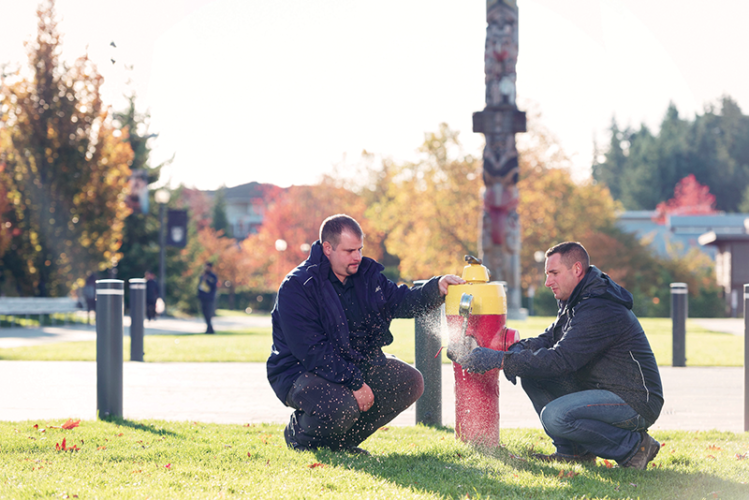Water is a crucial resource at the University of British Columbia (UBC) for basic human needs and to support research and operations. The simple act of turning on a tap to access a safe and reliable water supply is something more than 60,000 students, faculty, and staff depend on each and every day.
Although UBC isn’t technically a municipality, in many ways it operates like one—maintaining a vast infrastructure and supplying its own critical services. Managing UBC’s water alone is an intricate process and involves staff members from across UBC’s VP Finance & Operations portfolio (VPFO).
These in-house teams work in concert every day to ensure the university has a clean, safe, and sustainable resource on tap—by procuring, securing, testing, delivering, financially managing, and safely disposing of the university’s water.
Water makes its campus entrance
UBC’s water is purchased from Metro Vancouver and sourced from rain and melted snow in the mountainous watersheds that surround the city. Metro Vancouver tests and treats the water, then it travels many kilometres through pipes to the Sasamat storage reservoir in Pacific Spirit Park, adjacent to UBC and about 30 minutes from Vancouver’s downtown core.
Water enters the Vancouver campus through two trunk water mains. A pipe 600-millimetres in diameter runs below University Boulevard, and a 300-millimetre pipe enters below West 16th Avenue. The 600-millimetre pipe heads straight for the Power House at 2040 West Mall, where booster pumps increase the water pressure for distribution to the student residences and academic buildings in the north part of campus.
The taller buildings in this zone need their water under higher pressure to reach upper floors in the event of a fire. The 300-millimetre pipe mostly supplies residential buildings and student residences along Lower Mall. Water arrives through the 300-millimetre main at sufficient pressure to service the shorter buildings in this zone. From those two entry points, water is distributed across campus through over 80-kilometres of pipes and service connections.

Keeping the pipes working and the water flowing
One of the many people involved in maintaining that maze of pipes is Roger Cerny, head plumber for UBC’s Energy & Water Services department. Roger, who has more than 15 years of experience on campus, oversees a crew of eight, plus two labourers, to ensure the system stays in good working order and UBC’s spaces can fulfill their mission and purpose.
“I have lots of senior people on my crew, and I’m very, very fortunate to have them,” Roger said. “We safeguard our system [and] we protect the drinking water. We’re very proud of it.”
In addition to the many kilometres of pipes Roger and his team maintain, the distribution system has 2,100 shutoff valves and 440 fire hydrants, each of which needs to be tested annually. The campus also has seven pressure-reducing valve stations and two check valves that ensure water is at the right pressure where it needs to be. And this is all before water even enters our buildings.
To make maintenance of all these components manageable, their locations and status are stored in a database. When Roger and his team test a valve, they use an iPad to scan a QR code on the item and register the inspection. The system continues to be expanded to include the thousands of assets managed by Energy and Water Services, making it easy to find and repair components across campus.
“Anybody who finds a problem with any of our assets, like a fire hydrant leaking, can scan it and we would get that information and be able to do the repairs necessary,” Roger said. “It’s like we have extra eyes in the field—that really helps us out.”

Another vital part of Roger’s and his team’s work is to maintain the pipes themselves. He estimates that in 2018 alone they removed 2,200-metres of old cast iron water main. These are typically replaced with ductile iron pipes, which are more flexible and less susceptible to corrosion.
Once water enters a building, it becomes the responsibility of UBC Building Operations, another team from the VPFO. Sub-head Plumber Paul McLaughlin, who has been with UBC for 13 years, notes the importance of having an experienced in-house team of plumbers, engineers, and technicians. “We know how everything works,” McLaughlin said. “Everybody knows the buildings, and we know the people within buildings—that’s huge.”
This article was written by Chris Freek, Annie Mullins, Yvonne Kwok, and Alfie Penfold from the University of British Columbia. Read the full article in the May/June 2020 issue of Water Canada.









